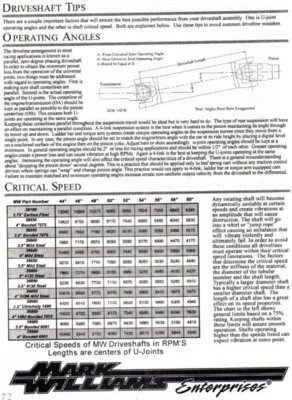Dave145
Well-Known Member
I still can't get rid of this vibration in my '64 Polara. Here's hoping this thread won't need a part 4...
Here's the scenario. It vibrates from 65mph on up. Currently it starts with what feels like a bad u joint kind of vibration in the rear, then by 70-75mph it starts a pounding kind of vibration under the front seat. Steering wheel is steady and doesn't vibrate. Coasting and decelerating has no effect on the vibration. Putting the car in neutral doesn't affect it either.
The car is a '64 four door hardtop Polara. It's got a bone stock Poly 318/727 in it, along with it's its original 741 case 8.75 rear end (2.76 ratio).
To date, here's what's new/replaced, for those who are just tuning in PR don't want to read the other threads on this (they're really long and hard to weed through).
New rubber motor mounts
New polyurethane transmission mount
Motor verified level when mounts were installed
Full tune up (NGK plugs, O'Reilly wires)
Pro-form electronic ignition kit (orange box)
New cap and rotor with distributor
Accel super stock coil
Rebuilt Motorcraft 2100 carb (originally was a very worn out Stromberg)
New Monroe shocks in the front
New Gabriel air shocks in the rear
Front end rebuilt with Moog bushings
Tie rods, ball joints, pitman and idler arms replaced with Moog components
Stock torsion bars
New timken wheel bearings up front (inner and outer)
Front brake drums have been turned
Rebuilt original ball and trunnion driveshaft and replaced ujoint
Later replaced driveshaft entirely and had one made with two ujoints and a slip yoke *this shaft is currently in the car*
Replaced rear brake drums and converted to 65-up "slip on" drums
Replaced rear wheel flanges (part with wheel studs in it)
Replaced leaf springs with new ones from ESPO. Stock 5 leaf springs.
New gas tank, sending unit, fuel pump, fuel filter
New rear outer wheel bearings
Tried two sets of steel stock wheels
Tried three different sets of tires (current tires are MasterCraft Avengers 215/70r14 size)
Aligned at a local shop in town
Rebuilt all brakes and verified ebrake isn't hanging up or sticking.
At this point we are still questioning pinion angle. Here are the measurements I took last night usuing my phone's inclinometer.
Trans: 3-4 degrees down
Driveshaft: 2.1 degrees down
Pinion: 4 degrees up
I have tried adding 2 degree shims under the rear end to give me 2 degrees up. This didn't change the vibration at all.
I have 70lbs of air in my rear shocks to give the car a forward take a bit. Vibration is the same with shocks aired up or down.
Tires have 32lbs of air in each tire.
The car does not vibrate idling at any rpm. Car vibrates regardless of if it's warm or cold outside.
That's all I can think of for now.
Here's the scenario. It vibrates from 65mph on up. Currently it starts with what feels like a bad u joint kind of vibration in the rear, then by 70-75mph it starts a pounding kind of vibration under the front seat. Steering wheel is steady and doesn't vibrate. Coasting and decelerating has no effect on the vibration. Putting the car in neutral doesn't affect it either.
The car is a '64 four door hardtop Polara. It's got a bone stock Poly 318/727 in it, along with it's its original 741 case 8.75 rear end (2.76 ratio).
To date, here's what's new/replaced, for those who are just tuning in PR don't want to read the other threads on this (they're really long and hard to weed through).
New rubber motor mounts
New polyurethane transmission mount
Motor verified level when mounts were installed
Full tune up (NGK plugs, O'Reilly wires)
Pro-form electronic ignition kit (orange box)
New cap and rotor with distributor
Accel super stock coil
Rebuilt Motorcraft 2100 carb (originally was a very worn out Stromberg)
New Monroe shocks in the front
New Gabriel air shocks in the rear
Front end rebuilt with Moog bushings
Tie rods, ball joints, pitman and idler arms replaced with Moog components
Stock torsion bars
New timken wheel bearings up front (inner and outer)
Front brake drums have been turned
Rebuilt original ball and trunnion driveshaft and replaced ujoint
Later replaced driveshaft entirely and had one made with two ujoints and a slip yoke *this shaft is currently in the car*
Replaced rear brake drums and converted to 65-up "slip on" drums
Replaced rear wheel flanges (part with wheel studs in it)
Replaced leaf springs with new ones from ESPO. Stock 5 leaf springs.
New gas tank, sending unit, fuel pump, fuel filter
New rear outer wheel bearings
Tried two sets of steel stock wheels
Tried three different sets of tires (current tires are MasterCraft Avengers 215/70r14 size)
Aligned at a local shop in town
Rebuilt all brakes and verified ebrake isn't hanging up or sticking.
At this point we are still questioning pinion angle. Here are the measurements I took last night usuing my phone's inclinometer.
Trans: 3-4 degrees down
Driveshaft: 2.1 degrees down
Pinion: 4 degrees up
I have tried adding 2 degree shims under the rear end to give me 2 degrees up. This didn't change the vibration at all.
I have 70lbs of air in my rear shocks to give the car a forward take a bit. Vibration is the same with shocks aired up or down.
Tires have 32lbs of air in each tire.
The car does not vibrate idling at any rpm. Car vibrates regardless of if it's warm or cold outside.
That's all I can think of for now.

















